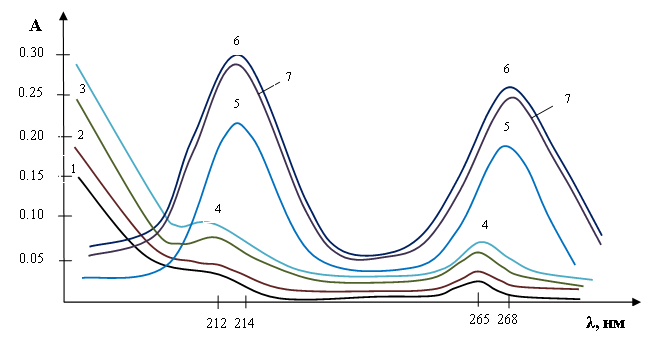COMPLEXATION OF APPLE PECTIN, MODIFIED TO PHARMACOPHORE, WITH THE CATIONS MANGANESE (II) IN AQUEOUS SOLUTIONS
UDC 547.458.88:541.49:541.572.54
Abstract
Complex formation in systems containing manganese (II), natural pectin and/or pectin modified by organic pharmacophores (nicotine, salicylic, 5-aminosalicylic, anthranilic acids) was studied by spectral (UV-, IR-, NMR 13C spectroscopy), potentiometric and viscometric methods. Method isomolar series and the molar relationship defined by the molar composition and the range of stability of metal complexes: pectin + nicotinic acid > pectin + acid 5-aminosalicylic > pectin + anthranilic acid > pectin + salicylic acid > native pectin. It is shown that the stability constant of metal complexes is significantly influenced by the reaction temperature and the structure of the pharmacophore. The presence of an amino group in the structure of an aromatic molecule increases the stability of metal complexes by 1.5–2 orders of magnitude. The standard thermodynamic characteristics (∆Hº; ∆Gº; ∆Sº) are calculated, which indicate that the processes of complexation in all cases are enthalpy-entropy favorable (∆Hº<0, ∆Sº>0) and proceed spontaneously (∆Gº<0). The influence of the structure of the drug compound in the polymer ligand on a number of physical and chemical properties of metal complexes was revealed. The data of NMR 13C and IR-spectra allow us to conclude that not only carboxyl groups but also hydroxyl functions of polymer matrices participate in the coordination interaction of pectin and/or pharmacophore-containing pectin with manganese (II) cations.
Downloads
Metrics
References
Minzanova S.T., Mironov V.F., Vyshtakalyuk A.B., Tsepayeva O.V., Mindubayev A.Z., Mironova L.G., Zobov V.V., Lenina O.A., Lantsova A.V., Konovalov A.I. DAN, 2009, vol. 429, no. 2, pp. 219–222. DOI: 10.1134/S0012500809110111 (in Russ.).
Petrov Yu.S., Neudachina L.K. Zhurnal neorganicheskoy khimii, 2014, vol. 59, no. 8, pp. 1133–1137. DOI: 10.7868/S0044457X14080169 (in Russ.).
Demetgul C. Carbohydrate Polymers, 2012, vol. 89, pp. 354–361, DOI: 10.1016/j.cabpol.2012.03.013.
Miyada T., Nakajima A., Ebihara K. British Journal of Nutrition, 2012, vol. 107, no. 10, pp. 1452–1457. DOI: 10.1017/ S0007114511004594.
Kaysheva N.Sh., Kayshev A.Sh. Zhurnal fizicheskoy khimii, 2015, vol. 89, no. 7, pp. 1122–1128. DOI: 10.7868/S0044453715070146 (in Russ.).
Sibikina O.V., Iozep A.A., Moskvin A.V. Khimiko-farmatsevticheskiy zhurnal. 2009, vol. 43, no. 6, pp. 35–39. DOI: 10.30906/0023-1134-2009-43-6-35-39 (in Russ.).
Minzanova S.T., Mironov V.F., Vyshtakalyuk A.B., Tsepaeva O.V., Mironova L.G., Mindubaev A.Z., Nizameev I.R., Kholin K.V., Milyukov V.A. Carbohydrate Polymers, 2015, vol. 134, pp. 524–533. DOI: 10.1016/j.carbpol.2015.07.034.
Karaseva A.N., Mironov V.F., Tsepayeva O.V. Khimiya i komp'yuternoye modelirovaniye. Butlerovskiye soobshcheniya, 2004, vol. 5, no. 1, pp. 33–35 (in Russ.).
Sychev A.Ya., Isak V.G. Uspekhi khimii, 1993, vol. 62, no. 3, pp. 303–315. DOI: 10.1070/RC1993v062n03ABEH000018 (in Russ.).
Kukovinets O.S., Mudarisova R.Kh., Sagitova A.F., Abdullin M.I. Zhurnal obshchey khimii, 2017, vol. 87, no. 4, pp. 645–649. DOI: 10.1134/S1070363217040181 (in Russ.).
Slivkin D.A., LapenkoV.L., Safonova O.A., Suslina S.N., Belenova A.S. Vestnik VGU. Seriya: Khimiya. Biologiya. Farmatsiya, 2011, no. 2, pp. 214–232 (in Russ.).
Feofanova M.A., Frantseva Yu.V., Zhuravlev Ye.V., Ryasenskiy S.S., Baranova N.V. Zhurnal fizicheskoy khimii. 2013, vol. 87, no. 8, pp. 1432–1434. DOI: 10.7868/S0044453713080128 (in Russ.).
Mashkovskiy M.D. Lekarstvennyye sredstva. [Medicines]. Moscow, 1984, vol. 2, 405 p. (in Russ.).
Zolotov Yu.A. Osnovy analiticheskoy khimii. Prakticheskoye rukovodstvo. [Fundamentals of analytical chemistry. A practical guide]. Moscow, 2001, 463 p. (in Russ.).
Kukovinets O.S., Mudarisova R.Kh., Volodina V.P., Tarasova A.V., Mokina A.Z., Abdullin M.I. Khimiya prirodnykh soyedineniy, 2014, vol. 50, no. 1, pp. 48–51. DOI: 10.1007/s10600-014-0864-5 (in Russ.).
Rafikov S.R., Budtov V.P., Monakov Yu.B. Vvedeniye v fiziko-khimiyu rastvorov polimerov. [Introduction to the phys-ical chemistry of polymer solutions]. Moscow, 1978. 328 p. (in Russ.).
Bulatov I.P., Kalinkin M.I. Prakticheskoye rukovodstvo po fotometricheskim metodam analiza. [A practical guide to photometric analysis methods]. Leningrad, 1986, 432 p. (in Russ.).
Al'bert A., Serzhent E. Konstanty ionizatsii kislot i osnovaniy. [Acid and base ionization constants]. Moscow, Lenin-grad, 1964, 380 p. (in Russ.).
Mironov V.F., Karaseva A.N., Tsepayeva O.V., Vyshtakalyuk A.B., Minzanova S.T., Morozov V.I., Karlin V.V., Yunusov E.R., Mindubayev A.Z. Khimiya i komp'yuternoye modelirovaniye. Butlerovskiye soobshcheniya, 2003, vol. 4, no. 3, pp. 45–50 (in Russ.).
Endryus L., Kifer R. Molekulyarnyye kompleksy v organicheskoy khimii. [Molecular complexes in organic chemistry]. Moscow, 1967, 206 p. (in Russ.).
Alekseyev Yu.Ye., Garnovskiy A.D., Zhdanov Yu.A. Uspekhi khimii, 1988, vol. 67, no. 8, pp. 723–744. DOI: 10.1070/RC1998v067n08ABEH000343 (in Russ.).

Copyright (c) 2020 Khimiia rastitel'nogo syr'ia (Chemistry of plant raw material)

This work is licensed under a Creative Commons Attribution 4.0 International License.

This work is licensed under a Creative Commons Attribution 4.0 International License.
The authors, which are published in this journal, agree to the following conditions:
1. Authors retain the copyright to the work and transfer to the journal the right of the first publication along with the work, at the same time licensing it under the terms of the Creative Commons Attribution License, which allows others to distribute this work with the obligatory indication of the authorship of this work and a link to the original publication in this journal .
2. The authors retain the right to enter into separate, additional contractual agreements for the non-exclusive distribution of the version of the work published by this journal (for example, to place it in the university depository or to publish it in a book), with reference to the original publication in this journal.
3. Authors are allowed to post their work on the Internet (for example, in a university repository or on their personal website) before and during the review process of this journal, as this may lead to a productive discussion, as well as more links to this published work.











